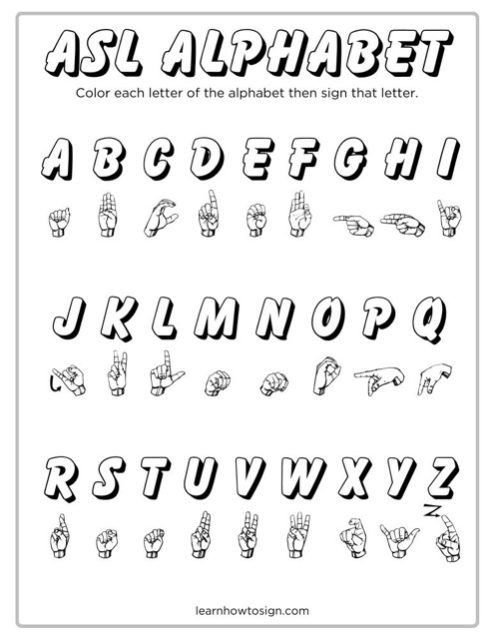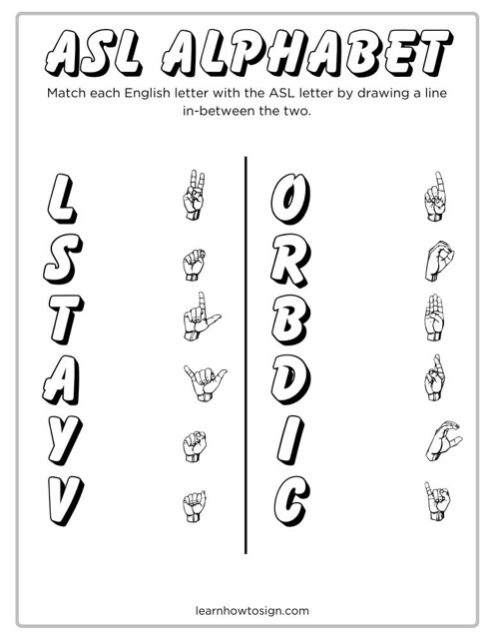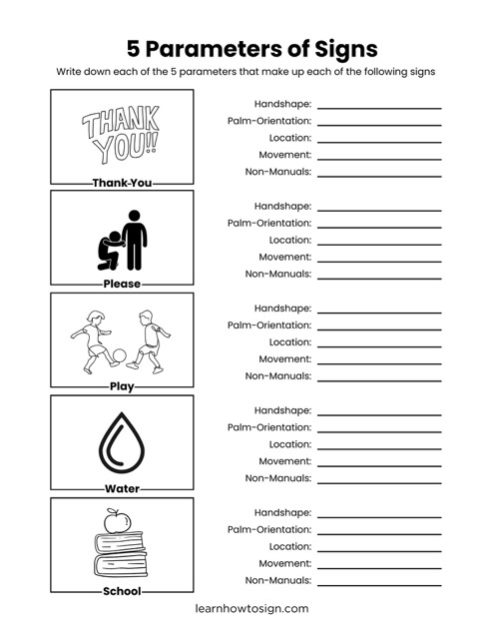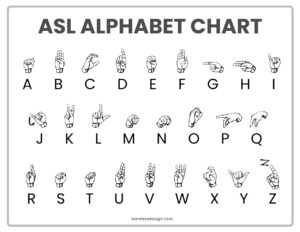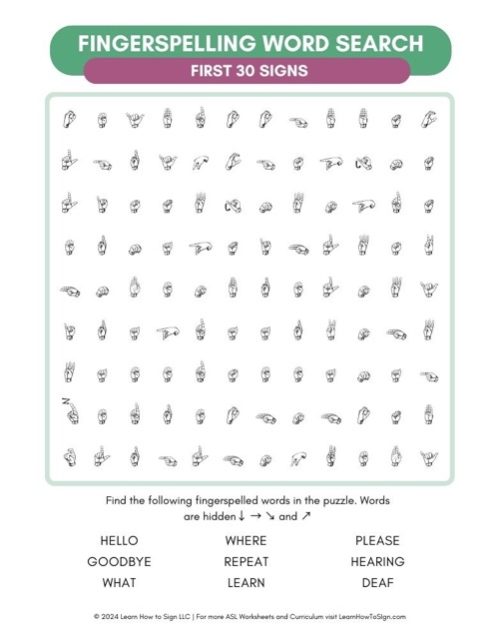Learn How to Sign @ HOME
Year 1 | Semester 1 | Week 1
Introduction
This week we’ll be covering some of the most important building blocks of American Sign Language. First, you’ll learn essential signs like thank you, more, bathroom, and finished, which will help you begin communicating right away. You’ll also be introduced to fingerspelling through the ASL alphabet, learning to recognize and produce each letter clearly. In grammar and culture, we’ll explore what to do with your hands in ASL and what makes it a complete visual language by looking at the five parameters of a sign. You’ll find a range of activities available depending on the age and level of the student. This week builds a strong foundation to support everything you’ll learn going forward.
Navigation
Vocabulary | Grammar and Culture | Fingerspelling and Numbers | Activities
Vocabulary
This week’s vocabulary section focuses on everyday signs that help students begin expressing basic needs and ideas in ASL. Words like thank you, eat, more, bathroom, and finished are practical and commonly used, making them a great starting point for building confidence and fluency. Students in Levels 1 and 2 are encouraged to focus on the core vocabulary list, while Level 3 learners will also be introduced to two additional signs that expand on this week’s theme. These optional signs are available for anyone who wants to challenge themselves, but they will be required and tested for Level 3 students during Week 5’s vocabulary assessment.
First Signs
Vocabulary List (23)
I/Me • You • My • Your • Yes • No • Thank-you • Sorry • Please • ASL • Bathroom • Eat • Drink • Sleep • Work • Play • Come • Go • Water • More • School • Home • Finished
First Signs (Additional)
Vocabulary List (2)
Pronouns (Possessive) • Pronouns (Personal)
Vocabulary Review
The Vocabulary Review section gives you a chance to practice the signs you just learned using flashcard sets. Click “Show Flashcards” to get started, then choose “Signs” for the core vocabulary list or “Signs +” if you want to include the additional signs. You can study in three ways: Flip to review the cards one at a time, Match to play a speed game pairing signs with their terms, or Quiz to test yourself with multiple choice questions. Use these modes throughout the week to keep practicing and get ready for your next assessment.
Review Flashcards
ASL Phrases
The ASL Phrases section teaches you how to sign 5 everyday English phrases in ASL using the signs you learned this week. These short, practical sentences help you connect your new vocabulary into simple conversations and see how the signs work together naturally. Practice them throughout the week to build fluency and confidence.
First Phrases
Phrases List (5)
Come here please • I finished my school work • I’m done • No thank you • Yes please
Grammar and Culture
This week in grammar, we’re starting with the basics: what do I do with my hands? We learn how your dominant and non-dominant hands work together in ASL, why keeping a natural rest position matters, and how finger names, handshapes, and the five parameters help create clear signs. By practicing these basics, you’ll build confidence and make your signing easier for others to understand.
What do I do with my Hands?
This lesson teaches how to use your dominant hand, maintain a clear rest position, recognize finger names and handshapes, and understand the five parameters of ASL to make your signs clear, consistent, and easy to understand.
Lesson Notes
Each grammar and culture lesson includes three downloadable PDFs. One is the lesson notes, which you can also view below. The other two are a fill-in-the-blank assignment and its answer key. The assignment is designed for Level 3 learners but is available for all levels. Click the links below to download each document.
Lesson Notes | Fill-In-The-Blanks | Answer Key
Dominant vs. Non-Dominant Hand
- You have two hands: right and left.
- The one you write or throw with is your dominant hand.
- The other is your non-dominant hand.
- Be consistent: always use the same hand to lead your signs.
- Tip: Wearing a watch can help you track your dominant hand.
Rest Position
- When not signing, keep your hands relaxed at your sides or gently in front of your body.
- A calm rest position keeps your message clear.
- Avoid fidgeting or holding random shapes.
Finger Names & Handshapes
- Index finger – the one you point with.
- Middle finger – the tallest one, often called the Feeler Finger in ASL.
- Ring finger – where a ring goes.
- Pinky – the smallest finger.
- Thumb – the one that sticks out.
- Handshapes describe how your hand looks:
- Y hand – thumb and pinky out.
- 5 hand – all five fingers spread.
The Five Parameters of Signs
- Handshape – what your hand looks like.
- Palm Orientation – which way your palm faces.
- Location – where the sign happens on the body.
- Movement – how your hand moves.
- Non-manual signals – what your face, head, and body do.
- Example: PLAY
- Handshape: Y hands
- Palm Orientation: facing each other
- Location: in front of the chest
- Movement: small outward flick
- Facial Expression: neutral
- Changing one parameter can change the entire meaning of a sign.
- Example: MOM (chin) vs. DAD (forehead).
Fingerspelling and Numbers
This week’s fingerspelling lesson focuses on the ASL alphabet. Students will learn how to form each letter clearly and accurately, using consistent handshapes and movements. The video breaks the alphabet down into small, manageable groups to help with memorization and flow. Mastering the alphabet is a key step in learning how to fingerspell names, places, and words that don’t have their own sign, so this is a foundational skill you’ll use often.
Learn the ASL Alphabet
This video breaks the ASL alphabet down into small, manageable groups to help with memorization and flow. You’ll learn how to sign letters A – Z and even have the opportunity to practice fingerspelling at the end. If you don’t learn it on the first pass, watch it again. The alphabet is a foundational part of ASL that you’ll build on in the future.
ASL Alphabet Review
This review section gives you a chance to practice the signs you just learned using our interactive digital flashcard sets. These flashcards are a great way to reinforce your memory and check your understanding. You can switch between different study modes: Flip, Match, or Quiz, to review in multiple ways. Try Match mode to compete for the fastest time and earn your spot on the leaderboard, or use Flip and Quiz modes to strengthen recall and test your accuracy. Use these flashcards throughout the week to build confidence and prepare for upcoming assessments.
Activities
Level 1 (Suggested for Grades K-2)
Playdough Alphabet Handshapes: Flatten out playdough and form the letter ‘A’ with your hand. Press it into the playdough to create an imprint of the handshape. Continue this process with the entire alphabet to visualize and reinforce each letter. Use the “ASL ABCs Chart” for additional support. Download PDF
Level 2 (Suggested for Grades 3-5)
Alphabet Matching Activity: Match the English letter with the ASL letter by drawing a line in-between the two. Download PDF
Level 3 (Suggested for Grades 6-8)
Parameters Activity: Let’s look at the parameters you just learned this week. Download and print the PDF. Write-down each of the 5 parameters that make up each of these 5 signs. Download PDF
- Ex. YES
- Handshape: S-hand
- Palm-Orientation: Facing out and down
- Location: Side of head
- Movement: Up and down
- Non-manual signals: Head nod
Related Resources
This section includes optional materials that complement the topics covered in this week’s lessons. While not part of the required curriculum, these curated videos, activities, and past course content are a great way to deepen your learning and explore ASL even further, all in one convenient place.
Learn The Alphabet (ABCs) with Kate
Learn the ASL alphabet with Meredith and Kate. Also learn about putting those letters together to spell words. The alphabet is so important because fingerspelling is used all the time in sign language.
Sign Language for Beginners | 10 Tips to Start ASL
This video provides crucial tips to get started with ASL, from learning strategies to cultural etiquette, ensuring a well-rounded understanding of the language.

Fingerspelling Names Activity
Practice fingerspelling your name and others. Do it in front of a mirror or on camera so you can see your signing from someone else’s perspective.
Learn How to Sign @ HOME
Learn How to Sign with our new and improved Homeschool Curriculum
Our goal is to make learning ASL fun and stress-free. We’ve done all the planning so you can focus on enjoying educational time with your kids. It’s flexible, comprehensive, and perfect for any homeschool family looking to add ASL to their learning journey.
About
the curriculum
Our ASL curriculum is carefully crafted to provide a comprehensive and engaging learning experience, structured to progressively build you and your child’s signing skills and cultural understanding. Each lesson is designed to be interactive and accessible, ensuring learners of all ages can effectively participate and grow.
This curriculum blends traditional learning methods with innovative educational tools, fostering both the technical skills needed for ASL proficiency and a deep appreciation for Deaf culture. Through a variety of formats including video lessons, interactive activities, and community interactions, students gain a well-rounded education.
This new curriculum features regular assessments so you can measure your students progress.
What's Inside?
Gain ASL proficiency with structured, easy-to-follow video lessons that cater to all learning levels.
Engage learners of all ages with activities from coloring pages to projects that reinforce ASL concepts.
Enhance your understanding of the Deaf community with rich cultural content integrated into each unit.
Every 5th week there is a review and assessment for everything that your student has learned in that unit. There are 3 different levels of assessment based on your child’s learning level.
Unlock comprehensive resources, exclusive discounts, and community features through the Accelerated membership, enriching your ASL learning journey.
Join Meredith weekly for live Q&A sessions where she answers your ASL questions and teaches new lessons, enhancing your understanding of ASL concepts, signs and culture.
What people are saying about LHTS
My daughter is having a wonderful experience with LHTS. We are so pleased with the quality of teaching, the amazing community and professional curriculum. We can’t recommend the courses enough!!

Patty K
I have also taken a beginner ASL course elsewhere and learned basic ASL. However, after I discovered LHTS I learned so much more. The live intensive courses are amazing, my two boys and I love the Homeschool Program. I love being an Accelerated Member and being part of the LHTS family has brought so much joy to our ASL learning journey.

Rose S
When we started homeschool we knew we wanted to continue sign language and were thrilled to find the LHTS had a homeschool program! We bought it immediately and have been enthralled with it. The learning style is perfect for younger learners (and older ones like me). The signs and directions are clear and Meredith does a wonderful job explaining the regional/evolutionary variations on signs while still making them easy to understand.

Kendra S


